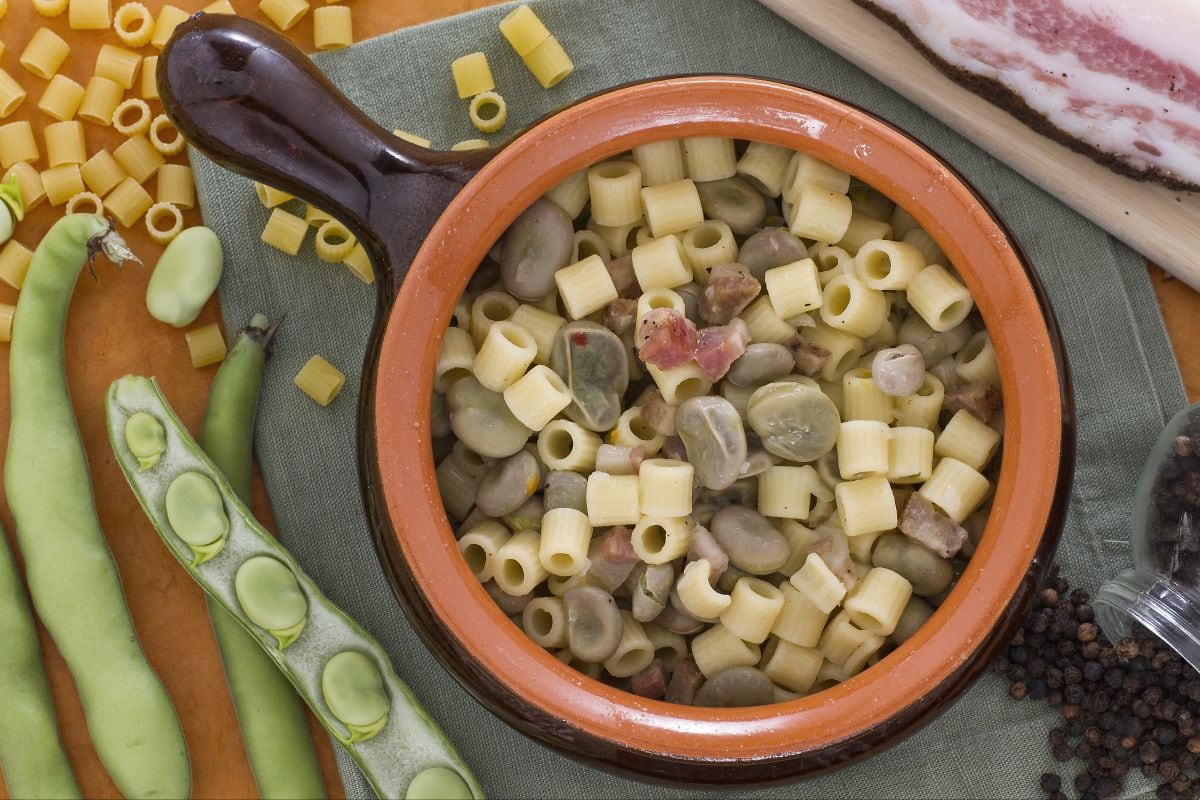Pasta and broad beans

- Lactose Free
- Energy Kcal 532
- Carbohydrates g 73.1
- of which sugars g 4.1
- Protein g 22.5
- Fats g 16.6
- of which saturated fat g 4.16
- Fiber g 8.8
- Cholesterol mg 19
- Sodium mg 1281
- Difficulty: Very easy
- Prep time: 15 min
- Cook time: 40 min
- Serving: 4
- Cost: Very low
PRESENTATION
Golden color with pale green from broad beans makes Pasta and Broad Beans a real winner for family meals. The soft, almost buttery pasta paired with the slightly nutty bite of broad beans creates a dish that’s both comforting and a little bit unique. Sprinkled with salty bits like cured pancetta and a good dose of truffled pecorino, every bite brings a nice balance between tender and crisp, cheesy and herb-fresh. Kids tend to love the fun lemony pasta flavor, while adults go for those simple but BIG flavors—think little bursts of freshness and just enough richness to make everyone happy. There’s something about dishes like this that feel right for spring, especially when folks want to keep things light but still DELICIOUS. Since it’s packed with mild, familiar tastes, this flavorful combination fits right at Sunday dinners, quick weekday lunches, or even as the highlight of a family get-together.
When pressed for time or juggling busy schedules, this easy pasta dish really shines for home cooks who need something straightforward with almost no decision stress. Serving as a go-to for anyone exploring broad bean recipes, it adapts easily—kids usually dig it plain, while adults may go for a generous dusting of cheese over the top. Works well hot or just at room temperature, which means you can tote it outside for garden parties or tuck leftovers in a lunchbox for the next day (definitely comes in handy.). The main thing is how versatile spring pasta like this can be, adding whatever seasonal extras you’ve got...fava beans with pancetta, a little more pecorino, or just some simple herbs and lemon juice for a bit of zing. Whenever families want a dish that looks pretty with mellow colors, feels just special enough, and gets finished fast, Italian pasta recipes with broad beans check every box. Easy, dependable, and always REALLY satisfying–this is one of those meals pretty much made for families wanting good food that tastes completely home-cooked.
You might also like:
- INGREDIENTS
- Ditaloni rigati pasta 3 ¼ cups (320 g)
- Fava beans 3 cups (500 g) - shelled
- Jowls 4.2 oz (120 g)
- Onions 1 - large
- Vegetable broth 4 ¼ cups (1 l)
- Extra virgin olive oil 4 spoonfuls
- Fine salt to taste
- Black pepper to taste
How to prepare Pasta and broad beans

To prepare pasta and broad beans, start with the pods of fresh broad beans: open them by breaking the top stem 1, then shell the beans with your hands 2. Once extracted, remove the small growth on the side of each one 3.

Cut the pork cheek into cubes 4 and place it, without any seasoning, in a non-stick pan to brown over low heat until the fat melts and the pork cheek is golden 5. Clean and chop a large onion and add it to the pan along with the pork cheek 6;

also add 4 tablespoons of extra virgin olive oil and let the onion turn golden 7. At this point, add the shelled broad beans 8, stir. After a few minutes, add a couple of ladles of broth 9 and let it cook over low heat for about 20-25 minutes (it might take a few more minutes depending on the size of the broad beans),

covering the pan with a lid 10 and leaving a small vent. During cooking, add vegetable broth whenever needed until the broad beans are cooked; adjust salt and pepper, then stir and turn off the heat 11. Boil the ditali rigati in plenty of salted boiling water 12 and, halfway through cooking, drain them, keeping some of their cooking water aside.

Add the ditali rigati to the broad beans 13 and continue cooking, stirring 14 and adding the reserved cooking water when needed. You can choose, depending on your taste, whether to get a rather dry dish or slightly soupy. When the pasta and broad beans are al dente, turn off the heat, add a couple of tablespoons of raw extra virgin olive oil, stir, and serve the pasta and broad beans 15, bringing grated parmesan to the table so your guests can use it as they please. Accompany the pasta and broad beans with a good red wine.